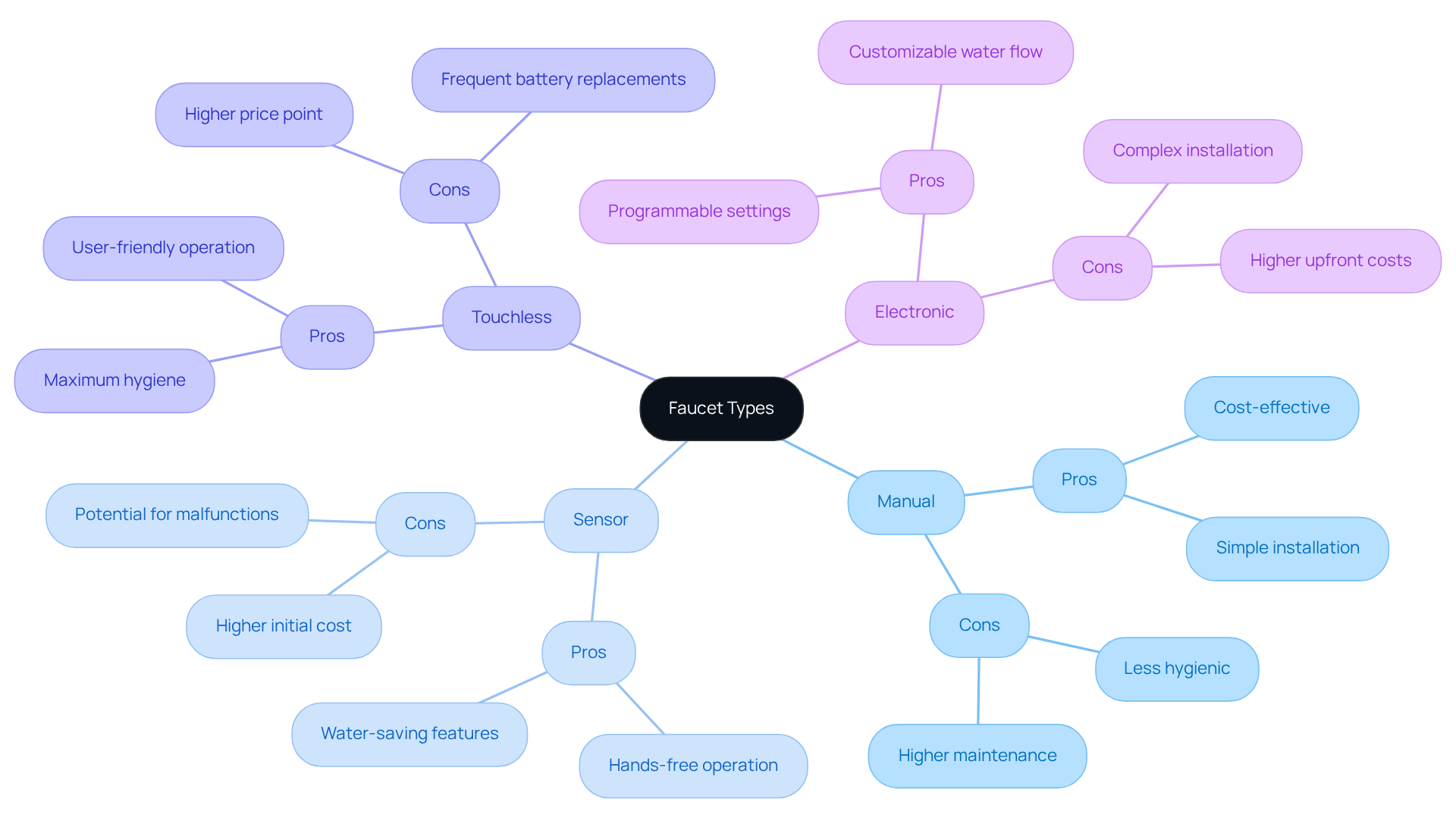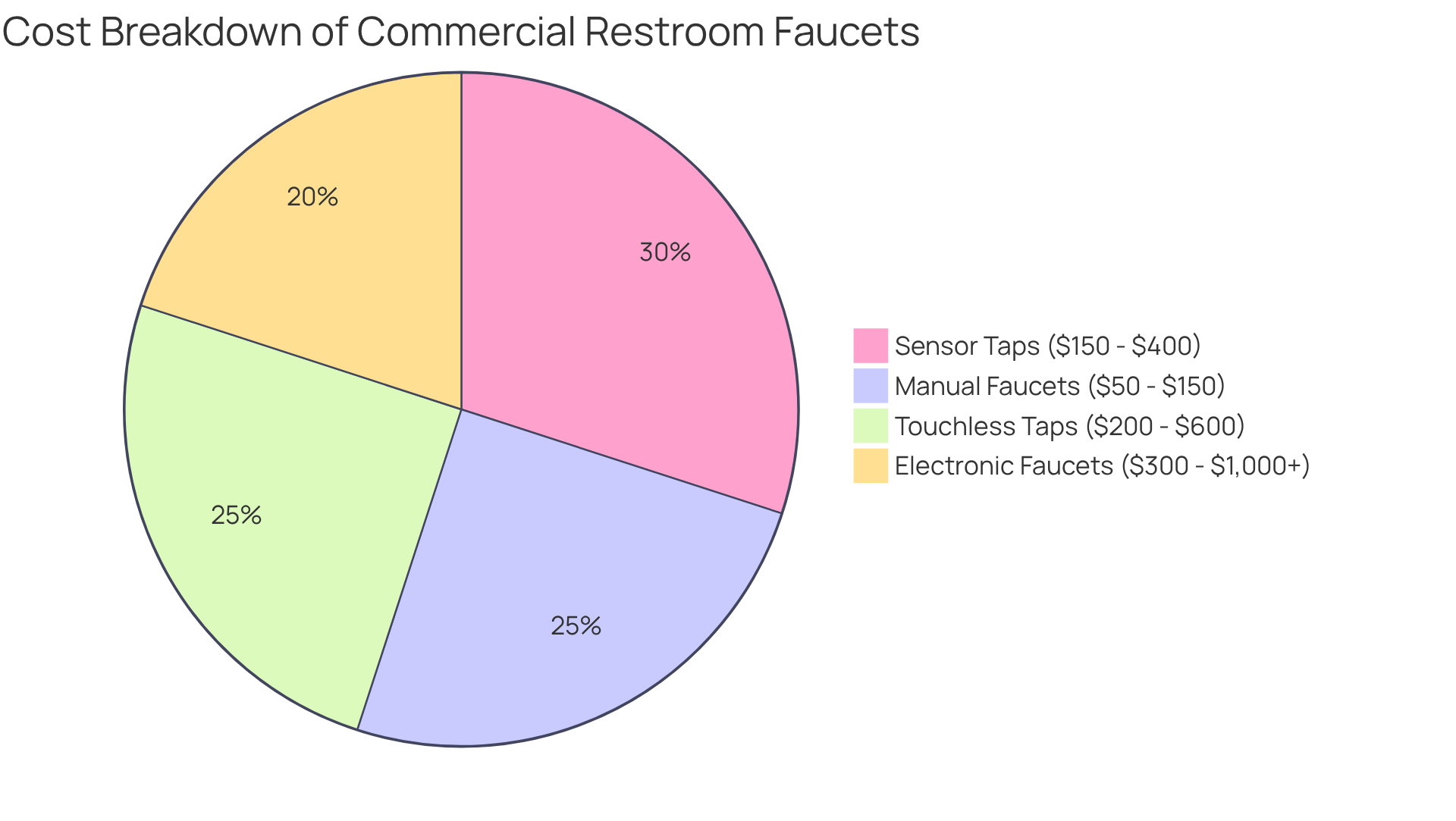Overview
This article provides a comprehensive comparison of commercial restroom faucets, meticulously examining their features, costs, and benefits. It highlights the distinctions among:
- Manual faucets
- Sensor faucets
- Touchless faucets
- Electronic models
Establishing a clear understanding of each type's unique advantages. While manual faucets are recognized for their cost-effectiveness, the article emphasizes that sensor and touchless options significantly enhance hygiene and efficiency. This added value can justify their higher costs, ultimately guiding facility managers in selecting the most suitable faucet type based on their operational needs and budget considerations.
Introduction
Commercial restroom faucets are essential for upholding hygiene and efficiency in public facilities. However, the overwhelming variety of options—from traditional manual taps to advanced touchless models—presents unique features tailored to diverse operational needs and budgets. As facility managers weigh the advantages and disadvantages of these faucets, a pivotal question emerges: which faucet type achieves the ideal balance between cost, functionality, and hygiene in an ever-evolving commercial landscape?
Overview of Commercial Restroom Faucets
Commercial restroom faucets are available in a range of types, each meticulously designed to cater to specific needs and preferences. The primary categories include:
- Manual Taps: These conventional fixtures require users to twist a handle to control the water flow. While they are often more affordable, they may not provide the same level of hygiene as touchless options.
- Sensor Taps: Triggered by motion detectors, these fixtures deliver a hands-free experience, significantly minimizing the risk of cross-contamination and enhancing cleanliness in public restrooms.
- Touchless Taps: Functioning without physical contact, touchless versions often incorporate advanced technology for both water conservation and user convenience, paralleling the benefits of sensor models.
- Electronic Taps: These fixtures may feature programmable options, allowing for customization of water flow and temperature, making them ideal for upscale commercial settings.
Each type of commercial restroom faucet addresses a variety of operational needs, ranging from basic functionality to advanced hygiene and efficiency aspects. Consequently, it is imperative for facility managers and designers to select the appropriate option based on their specific restroom requirements.

Key Features of Leading Faucet Models
Top commercial restroom faucets exemplify a range of attributes that significantly enhance their functionality and user experience.
- Water Efficiency stands out as a critical feature; many modern faucets are meticulously designed to minimize water usage without compromising performance, often meeting or exceeding EPA WaterSense standards.
- Durability is another key aspect, as high-quality materials such as stainless steel and PVD finishes ensure longevity and resistance to wear and tear, making these fixtures ideal for high-traffic environments.
- Furthermore, the Hygienic Design of commercial restroom faucets, including touchless and sensor-operated taps, reduces the need for physical contact, thereby promoting better hygiene and minimizing the spread of germs.
- In addition, models that allow for above-deck maintenance simplify upkeep, making them more convenient for facility managers.
- Finally, the aesthetic appeal of many commercial restroom faucets is noteworthy; they are designed with contemporary aesthetics in mind, allowing them to blend seamlessly into modern restroom designs.
These attributes not only enhance user satisfaction but also contribute to the overall effectiveness and sustainability of restroom facilities.

Pros and Cons of Each Faucet Type
When selecting commercial restroom faucets, it is crucial to understand the advantages and disadvantages of each type to make an informed decision:
-
Manual Faucets: These faucets are cost-effective and feature a simple design that makes installation straightforward. However, they are less hygienic, pose a higher risk of cross-contamination, and may require more maintenance than other options.
-
Sensor Faucets: Offering hands-free operation, these faucets enhance hygiene and incorporate water-saving features. Nevertheless, they come with a higher initial cost, the potential for sensor malfunctions, and may necessitate electrical installation.
-
Touchless Faucets: With maximum hygiene and user-friendly operation, touchless faucets often include advanced features such as temperature control. On the downside, they tend to have a higher price point and may require more frequent battery replacements or electrical maintenance.
-
Electronic Faucets: These faucets allow for programmable settings and customizable water flow, making them suitable for luxury environments. However, they entail complex installation, higher upfront costs, and the possibility of technical issues.
By carefully considering these factors, facility managers can select the faucet type that best aligns with their operational goals and budget.

Cost Analysis of Commercial Faucets
The cost of commercial restroom faucets can vary significantly depending on the type, brand, and features. Here’s an insightful breakdown:
- Manual Faucets: Typically range from $50 to $150, making them the most budget-friendly option. However, it's essential to consider that their long-term maintenance costs may offset initial savings.
- Sensor Taps: Generally priced between $150 and $400. While they require a higher upfront investment, their water-saving capabilities can lead to reduced utility bills over time.
- Touchless Taps: These fixtures can range from $200 to $600, depending on the technology and design. Their hygiene benefits and water efficiency often justify the higher cost.
- Electronic Faucets: Prices can start at $300 and go up to $1,000 or more for high-end models. The investment in these fixtures can be particularly beneficial for upscale commercial settings where user experience is essential.
Furthermore, alongside the purchase price, it’s crucial to take into account installation expenses, which can differ depending on the intricacy of the tap type. Overall, investing in higher-quality faucets may lead to lower maintenance and operational costs in the long run.

Conclusion
Selecting the appropriate commercial restroom faucet is essential for enhancing functionality, hygiene, and user experience in public facilities. Each faucet type—manual, sensor, touchless, and electronic—presents distinct advantages and potential drawbacks. Therefore, it is imperative for facility managers to evaluate their unique needs prior to making a decision.
Key considerations include the significance of water efficiency and durability, which are critical factors in any commercial restroom environment. The hygienic design of contemporary faucets, especially touchless and sensor-operated models, markedly reduces the risk of cross-contamination. Moreover, features such as above-deck maintenance simplify upkeep for facility managers. Additionally, comprehending the cost implications of each faucet type can facilitate more informed budgeting decisions, ensuring that the selected fixtures deliver long-term value.
In conclusion, investing in the right commercial restroom faucet transcends aesthetics or initial costs; it is fundamentally about fostering a safe, efficient, and pleasant experience for users. As trends evolve and technology advances, remaining informed about the latest features and benefits of commercial restroom faucets will empower facility managers to make choices that align with their operational goals and enhance overall restroom hygiene.
Frequently Asked Questions
What are the main types of commercial restroom faucets?
The main types of commercial restroom faucets include Manual Taps, Sensor Taps, Touchless Taps, and Electronic Taps.
How do Manual Taps work and what are their advantages?
Manual Taps require users to twist a handle to control the water flow. They are often more affordable but may not provide the same level of hygiene as touchless options.
What are Sensor Taps and how do they improve hygiene?
Sensor Taps are triggered by motion detectors, providing a hands-free experience that significantly reduces the risk of cross-contamination and enhances cleanliness in public restrooms.
What is the difference between Touchless Taps and Sensor Taps?
Touchless Taps function without any physical contact and often incorporate advanced technology for water conservation and user convenience, similar to Sensor Taps.
What features do Electronic Taps offer?
Electronic Taps may include programmable options that allow for customization of water flow and temperature, making them suitable for upscale commercial settings.
Why is it important for facility managers to choose the right type of faucet?
Selecting the appropriate faucet type is crucial for addressing specific restroom requirements, ranging from basic functionality to advanced hygiene and efficiency needs.




